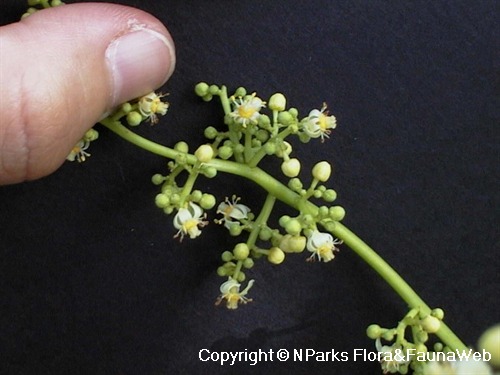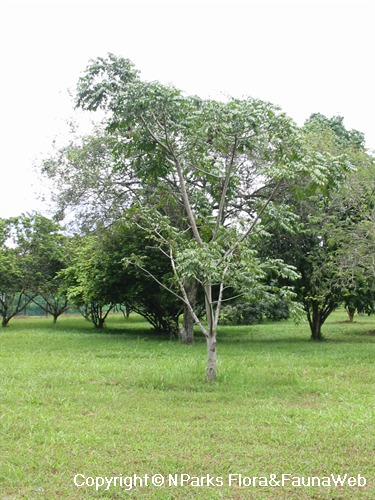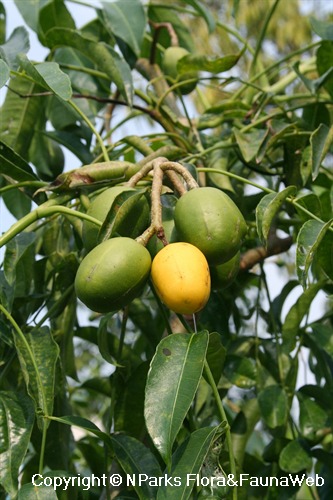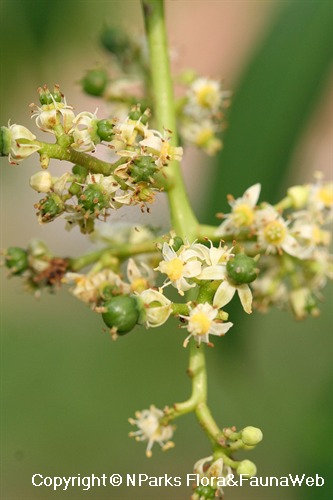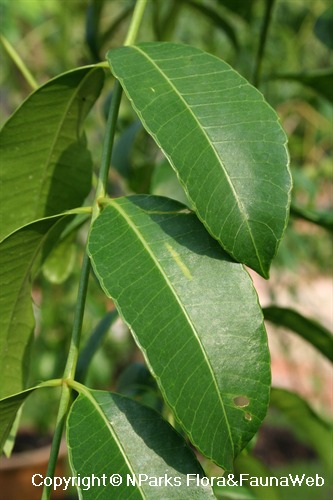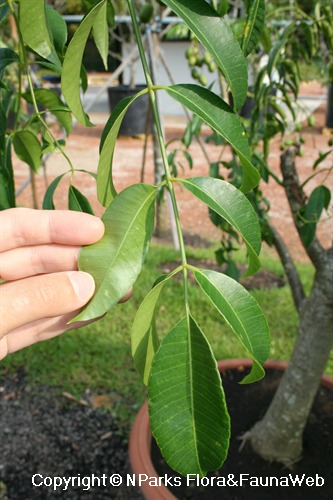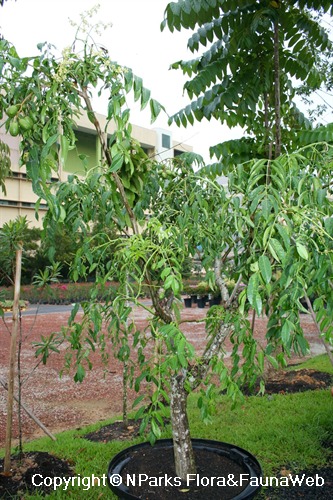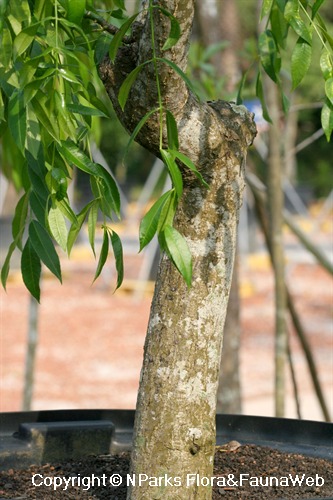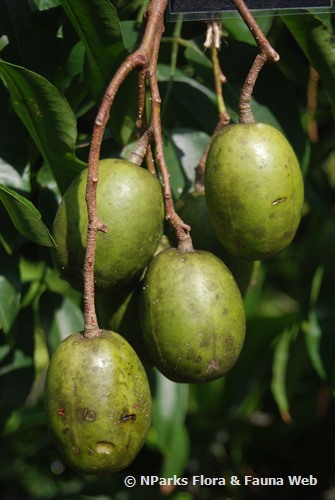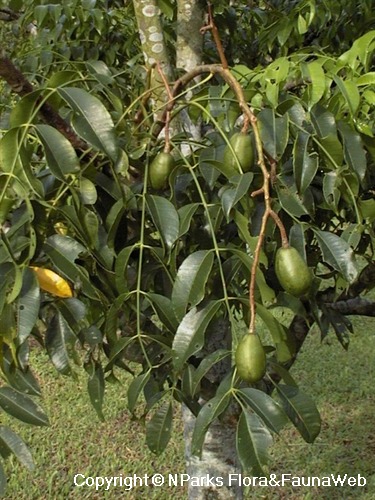
Back
Spondias dulcis Parkinson
| Family Name: | Anacardiaceae |
| Synonyms: | Spondias cytherea |
| Common Name: | Kedondong, Great Hog Plum, Golden Apple, Otaheite Apple, Yellow Plum, Jew Plum, Ambarella |
Name
Classifications and Characteristics
| Plant Division | Angiosperms (Flowering Seed Plants) (Dicotyledon) |
|---|---|
| Plant Growth Form | Tree (Small (6m-15m)) |
| Lifespan (in Singapore) | Perennial |
| Mode of Nutrition | Autotrophic |
| Plant Shape | Irregular, Weeping / Pendulous, Open |
| Maximum Height | 9 m to 12 m |
Biogeography
| Native Distribution | Indochina, Malesia, Polynesia |
|---|---|
| Native Habitat | Terrestrial (Primary Rainforest) |
| Preferred Climate Zone | Tropical |
Description and Ethnobotany
| Others - Plant Morphology | Small fruit tree, 9m-12m in ground under cultivation. Up to 2m when grown in container. Prefers well-drained soil.Flowers white, small, inconspicuous, borne in large panicles. Free-flowering. Fruits edible, ripen from green to golden yellow. Pulp is crisp, sour-sweet, with pineapple-like fragrance. Rich in Vitamin C. Flat seeds contained in fibrous core. Fruits used in local Malay dish rojak.Propagate by seeds or hardwood stem cuttings. Plants grown from seeds may start fruiting within 4 years. |
|---|---|
| Ethnobotanical Uses | Edible Plant Parts : Edible Fruits, Edible Leaves Food (Fruit or Vegetable) Others: Ripe fruits eaten raw or cooked, made into juice. Unripe fruits made into jellies, pickles or used to flavour soups and stews. Acidic young leaves eaten raw, steamed or cooked with meat. |
Landscaping Features
| Desirable Plant Features | Fragrant (Fruits, Roots) |
|---|---|
| Landscape Uses | Container Planting |
| Thematic Landscaping | Economic Garden |
Plant Care and Propagation
| Light Preference | Full Sun |
|---|---|
| Water Preference | Moderate Water |
| Plant Growth Rate | Fast to Moderate |
| Rootzone Tolerance | Well-Drained Soils |
| Maintenance Requirements | Moderate |
| Diseases | Leaves may be attacked by larvae of Kedongdong Spring-Beetle, Podontia affinis. |
| Pest(s) | Associated with, Chewing Insects |
| Propagation Method | Seed, Stem Cutting, Grafting, Air-Layering |
| Propagule Establishment Remarks | Seeds germinate within 4 weeks of being sowed. |
| Propagation Method Remarks | Use large hardwood cuttings. May be grafted onto rootstock of same species or Spondias pinnata. |
Foliar
| Foliage Retention | Evergreen |
|---|---|
| Mature Foliage Colour(s) | Green |
| Mature Foliage Texture(s) | Smooth, Glossy / Shiny, Raised / Sunken Veins |
| Foliar Type | Simple / Unifoliate |
| Foliar Arrangement Along Stem | Opposite |
| Foliar Shape(s) | Non-Palm Foliage (Obovate, Elliptical, Oblong) |
| Foliar Venation | Pinnate / Net |
| Foliar Margin | Serrate / Toothed |
| Typical Foliar Area | Notophyll ( 20.25cm2 - 45 cm2 ) |
| Leaf Area Index (LAI) for Green Plot Ratio | 2.5 (Tree - Open Canopy) |
Non - Foliar and Storage
| Trunk Type (Non Palm) | Woody |
|---|---|
| Bark Colour(s) | Light grey-brown |
| Stem Type & Modification | Woody |
| Root Type | Underground (Tap Root, Fibrous Root) |
Floral (Angiosperm)
| Flower Colour(s) | White |
|---|---|
| Flower Symmetry | Radial |
| Flower Size - Remarks | Small, inconspicuous |
| Inflorescence Type | Panicle |
| Flowering Period | Free-Flowering |
| Flowering Opening Time | Time-Independent |
| Flowering Habit | Polycarpic |
Fruit, Seed and Spore
| Mature Fruit Colour(s) | Yellow / Golden |
|---|---|
| Fruit Classification | Simple Fruit |
| Fruit Type | Fleshy Fruit , Drupe |
Image Repository
Others
| Master ID | 1841 |
|---|---|
| Species ID | 3134 |
| Flora Disclaimer | The information in this website has been compiled from reliable sources, such as reference works on medicinal plants. It is not a substitute for medical advice or treatment and NParks does not purport to provide any medical advice. Readers should always consult his/her physician before using or consuming a plant for medicinal purposes. |

